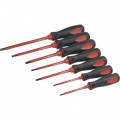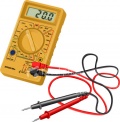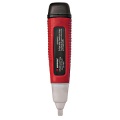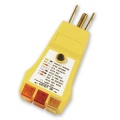Electrical Tools: Difference between revisions
Jump to navigation
Jump to search
Wvengineer (talk | contribs) |
No edit summary |
||
| (6 intermediate revisions by one other user not shown) | |||
| Line 1: | Line 1: | ||
== Must have tools == | == Must have tools == | ||
==== Wire Strippers ==== | |||
<TABLE WIDTH=90%> | |||
<TR><TD> | |||
A good pair of wire strippers insures that the insulation has been properly removed, nicking the wire can cause physical failure when bending takes place or in other extreme cases hot spots can occur because of the reduced conductor size causing resistance heating leading to electrical failure or fire on circuits under heavy loads. some upper end expensive wire strippers use a thermal process to burn away the insulation rather than using a sharp blade to cut the insulation</TD> | |||
<TD>[[Image:strippers.jpg|120px]]</TD></TR> | |||
</TABLE> | |||
==== Digital Multi Meter ==== | ==== Digital Multi Meter ==== | ||
| Line 10: | Line 18: | ||
====Non contact voltage probe ==== | ====Non contact voltage probe ==== | ||
<TABLE WIDTH=90%> | <TABLE WIDTH=90%> | ||
<TR> | <TR><TD> | ||
<TD> | |||
Non-Contact Voltage Detectors can be used to detect the presence of voltage at outlets, lighting fixtures, circuit breakers, wires and cables or can be even used to find a break in a wire. Most can detect the presence of voltages with the range of 50 to 1000 volts ac and a frequency ranging 50 to 500 hertz. some of the higher end units can detect the presence of dc voltages. this item can be found at most hard ware stores for as little nine bucks! Very cheap when you compare the cost of the life savings. | Non-Contact Voltage Detectors can be used to detect the presence of voltage at outlets, lighting fixtures, circuit breakers, wires and cables or can be even used to find a break in a wire. Most can detect the presence of voltages with the range of 50 to 1000 volts ac and a frequency ranging 50 to 500 hertz. some of the higher end units can detect the presence of dc voltages. this item can be found at most hard ware stores for as little nine bucks! Very cheap when you compare the cost of the life savings. | ||
</TD></TR></TABLE> | </TD> | ||
<TD>[[Image:wire-probe.jpg|120px]]</TD> | |||
</TR></TABLE> | |||
====GFI circuit tester ==== | ====GFI circuit tester ==== | ||
| Line 21: | Line 30: | ||
</TD> | </TD> | ||
<TD>[[Image:Gfi-test.jpg|120px]]</TD> | <TD>[[Image:Gfi-test.jpg|120px]]</TD> | ||
</TR></TABLE> | |||
====Circuit Breaker Lockout Tags ==== | |||
<TABLE WIDTH=90%> | |||
<TR><TD> | |||
The use of Lockout-Tagout or (LOTO) is the safety measure widely used when someone is working on an electrical circuit and uses a way to physically disable the circuit from being accidentally energized, thus keeping the person from being electrocuted. | |||
</TD> | |||
<TD>[[Image:lockout.jpg|120px]]</TD> | |||
</TR></TABLE> | </TR></TABLE> | ||
| Line 31: | Line 49: | ||
</TD></TR></TABLE> | </TD></TR></TABLE> | ||
[[Category:General Info]] | |||
[[Category:DIYC Index]] | |||
Latest revision as of 01:46, 29 January 2011
Must have tools
Wire Strippers
Digital Multi Meter
Non contact voltage probe
GFI circuit tester
Circuit Breaker Lockout Tags
Not needed but nice to have
Insulated screwdrivers
 |




